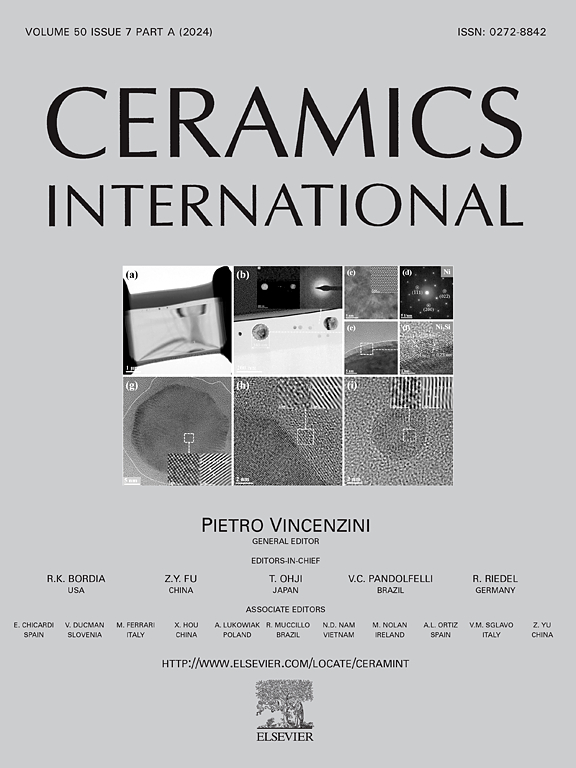Gd2O3-Ta2O5体系的相平衡:新的高温实验和热力学模型
IF 5.1
2区 材料科学
Q1 MATERIALS SCIENCE, CERAMICS
引用次数: 0
摘要
采用CO2激光加热装置结合高速高温计对Gd2O3-Ta2O5体系的相变进行了新的高温实验。用x射线衍射仪和扫描电镜研究了铸态试样的凝固特征。共晶反应为:Liquid→F-Gd3TaO7+ B-Gd2O3、Liquid→F-Gd3TaO7+T-GdTaO4、Liquid→t - gdta3o4 +O-GdTa3O9和Liquid→O-GdTa3O9+α-Ta2O5。根据实验结果更新了它们的共晶成分和温度。液相→t - gdta3o9和液相→O-GdTa3O9的反应温度分别为2055℃和2010℃。讨论了h-GdTa7O19在1400 ~ 1500℃之间形成的相稳定性。最后,应用CALPHAD方法对Gd2O3-Ta2O5体系进行了热力学优化。液相采用离子双亚晶格模型表征,中间化合物的热力学模型基于晶体结构建立。计算结果与实测数据的比较表明,所建立的热力学模型是合理的。本研究的发现可以促进钽酸钆材料的发展,并为相关多组分体系的相平衡和热力学数据库的建立提供理解。本文章由计算机程序翻译,如有差异,请以英文原文为准。
Phase equilibria in the Gd2O3-Ta2O5 system: New high-temperature experiments and thermodynamic modeling
A CO2 laser heating apparatus combined with a high-speed pyrometer was employed to conduct new high-temperature experiments on the phase transformation of the Gd2O3-Ta2O5 system. The solidification features of the as-cast samples were examined by means of an X-ray diffractometer and scanning electron microscopy. Four eutectic reactions were found in this study, namely Liquid→F-Gd3TaO7 +B-Gd2O3, Liquid→F-Gd3TaO7+T-GdTaO4, Liquid→T-GdTaO4+O-GdTa3O9 and Liquid→O-GdTa3O9+α-Ta2O5. Their eutectic compositions and temperatures were updated based on our experimental results. The congruent reaction temperatures of Liquid→T-GdTaO4 and Liquid→O-GdTa3O9 were determined to be at 2055 °C and 2010 °C, respectively. Moreover, phase stability of h-GdTa7O19, which can form between 1400 °C and 1500 °C, was discussed. Finally, the CALPHAD method was applied to conduct a thermodynamic optimization of the Gd2O3-Ta2O5 system. The liquid phase was characterized by the ionic two-sublattice model, while the thermodynamic models of intermediate compounds were formulated based on their crystal structures. The comparisons between the calculated results and the accessible experimental data show that our thermodynamic modeling is sound. The findings of this research can promote the development of gadolinium tantalate materials and offer understandings regarding phase equilibrium and the development of the thermodynamic database for relevant multicomponent systems.
求助全文
通过发布文献求助,成功后即可免费获取论文全文。
去求助
来源期刊

Ceramics International
工程技术-材料科学:硅酸盐
CiteScore
9.40
自引率
15.40%
发文量
4558
审稿时长
25 days
期刊介绍:
Ceramics International covers the science of advanced ceramic materials. The journal encourages contributions that demonstrate how an understanding of the basic chemical and physical phenomena may direct materials design and stimulate ideas for new or improved processing techniques, in order to obtain materials with desired structural features and properties.
Ceramics International covers oxide and non-oxide ceramics, functional glasses, glass ceramics, amorphous inorganic non-metallic materials (and their combinations with metal and organic materials), in the form of particulates, dense or porous bodies, thin/thick films and laminated, graded and composite structures. Process related topics such as ceramic-ceramic joints or joining ceramics with dissimilar materials, as well as surface finishing and conditioning are also covered. Besides traditional processing techniques, manufacturing routes of interest include innovative procedures benefiting from externally applied stresses, electromagnetic fields and energetic beams, as well as top-down and self-assembly nanotechnology approaches. In addition, the journal welcomes submissions on bio-inspired and bio-enabled materials designs, experimentally validated multi scale modelling and simulation for materials design, and the use of the most advanced chemical and physical characterization techniques of structure, properties and behaviour.
Technologically relevant low-dimensional systems are a particular focus of Ceramics International. These include 0, 1 and 2-D nanomaterials (also covering CNTs, graphene and related materials, and diamond-like carbons), their nanocomposites, as well as nano-hybrids and hierarchical multifunctional nanostructures that might integrate molecular, biological and electronic components.
 求助内容:
求助内容: 应助结果提醒方式:
应助结果提醒方式:


